The project of the aerospace system "Blizzard"
The project of the Vyuga aerospace system (ACS) was developed by the Moscow company Lin Industrial, working with the assistance of the Skolkovo Foundation, at the request of an unnamed customer. The aim of the project was to elaborate the shape of a reusable two-stage system designed for putting people and various cargoes into orbit. At the same time, due to the limited capacity of the system, the implementation of various scientific studies, etc. is considered as the main task. In addition, the military use of the system for the purposes of reconnaissance or as a carrier of high-precision weapons.
In the proposed form of the system "Blizzard" has a number of characteristic advantages. It provides full reusability of all system components, the use of an existing aircraft carrier, the ability to output the load into orbits in a wide range of inclinations, as well as environmental safety. In addition, the use of an aircraft carrier allows you to launch payloads from various regions of the planet, including taking off from the territory of the client country.
The project AKS "Blizzard" implies the use of a complex consisting of three main components. The main element that ensures the performance of the rest is a carrier aircraft with a set of fasteners for transporting the remaining equipment. It is also proposed to use the first stage with rocket engines, which is responsible for the acceleration of the so-called. orbital treads. The latter is an apparatus capable of flying both in the atmosphere and beyond. All elements of the Blizzard complex should be able to return to the base.
According to the development organization, the creation of the VKS “Vyuga” began with a study of the existing possibilities and the determination of the parameters of the required equipment. Thus, the payload of the complex was determined at the level of 450 kg, brought to a low earth load. It is noted that similar parameters of carrying capacity have technological satellites such as "Photon". Further, taking into account the calculations for the various elements of the complex, the range of potential carriers of the system was determined.
The An-124 “Ruslan” and An-225 “Mriya” military transport aircraft were decided to be abandoned due to excessive load-carrying characteristics. The missile Tu-160 did not fit due to the small number of existing machines of this type. As a result, only M-55X “Geophysics”, MiG-31 and IL-76 aircraft were considered. Further calculations showed that Geophysics and MiG-31 can not be used as a sparking aircraft of the aerospace system. These aircraft have a high practical ceiling, but they have insufficient payload. When using them, the Blizzard payload could not exceed 50-60 kg, which did not correspond to the initial calculations.
Thus, the IL-76 military transport aircraft was the only suitable carrier of the system. However, in this case, not all design features allowed using the equipment without any modifications. Calculations showed that for transportation and launch of the acceleration and orbital stages the aircraft needs to strengthen the structure and install some new equipment. Such improvements made it possible to most fully realize the existing advantages in the form of high payload, and also to compensate for the existing loss in altitude compared to other potential carriers.
The project "Blizzard" in its current form provides for the modernization of the IL-76 using some new units. In the central part of the aircraft's cargo compartment, it is proposed to mount a special support farm, redistributing the weight of the rocket systems to the aircraft power elements. This product is an openwork design with a length of 12,9 m, a width of 3,3 m and a height of 2,7 m with protruding elements in the upper part, displayed outside the fuselage. Initially, the farm was proposed to be made of carbon fiber, but later, for reasons of strength, the project was changed. Now the product should consist of titanium elements with a diameter of 85 mm. In this case, the weight of the truss is 6,2 t. Perhaps some relief of the structure by reducing the thickness of the parts of the lower part of the truss.
After installing the farm on the plane on the upper surface of its fuselage there are several nodes for docking with the first stage of the rocket system. With their help, it is proposed to associate the aircraft carrier with other elements of the complex. Fastenings must have control systems that ensure the discharge of missile systems at the required moment.
According to the results of preliminary design work and research using computer modeling, the designers of Lin Industrial created the overall appearance of the first stage of the Blizzard ACS. This product should be a relatively large aircraft with a rocket engine, designed to accelerate the orbital stage after separation from the aircraft-propeller. Such methods of application have led to the need to work out some of the design features. In particular, it was necessary to develop a wing and a stabilizer, designed to lead the missile system from the aircraft carrier after separation.
A rather simple construction of the first stage is proposed. All major units of this technology should be mounted on an elongated truss, which is the basis of the design. On the upper part of the farm, it is proposed to mount tanks for fuel and oxidizer, behind which the engine should be placed. In this case, the rear tank, in contrast to the front one, should have a more complex shape, necessary for the correct placement of the orbital stage. At the bottom of the truss there are mounting for planes. In view of the expected mechanical and thermal loads, the first stage should receive thermal protection of the lower part of the fuselage.
For flight in the atmosphere immediately after separation from the carrier and during landing, the first step of the "Blizzard" should use a set of different planes. In the central part of the fuselage, it is proposed to mount a low wing. Also developed two-tail tail with stabilizers of relatively small size. Inside the airframe it is proposed to mount the landing gear needed to return the first stage to the required airfield.
By now, it has been reported that the appearance of one of the main elements of the first stage - the oxidizer tank - has been formed. This product had high requirements for strength, volume, tightness and other parameters, up to the need to maximize the production of filled fluid. Given these requirements and the characteristics of liquid oxygen, the overall design of the tank was determined. The cylindrical side surface of the tank must be made of carbon fiber with an epoxy binder, and also receive an internal coating in the form of a film PMF-352. The latter is necessary to reduce the negative effects of low-temperature oxidant on composite parts. Frames and bottoms glued to the composite part are proposed to be made of an aluminum-magnesium alloy. Inside the tank should be installed partitions, dampers, pipelines and other necessary parts.
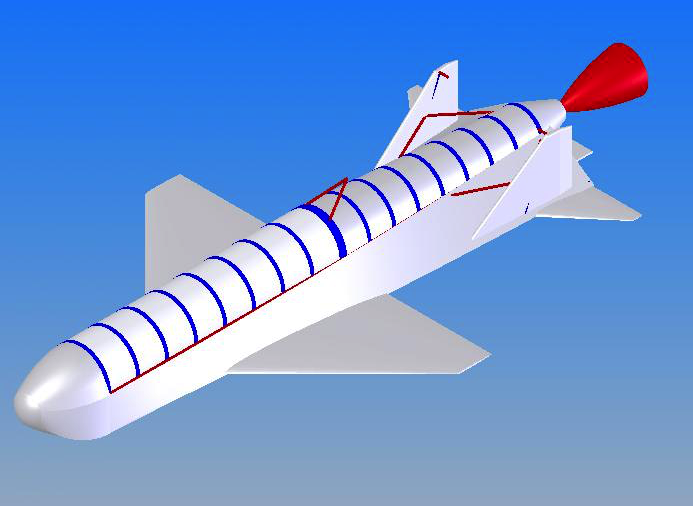
General view of the first stage
In the tail section of the first stage it is proposed to mount a single-chamber liquid-propellant rocket engine with the required characteristics. The power plant using kerosene and liquid oxygen should show the flow rate of gases at the level of 3,4 km / s, which will achieve the required thrust parameters. Estimated speed of the first stage - about 4720 m / s.
With a total length of 17,45 m, the first stage of the ACS “Blizzard” should have a dry weight of 3,94 t, a full starting one - 30,4 t. At the same time, most of the starting weight falls on fuel: 7050 kg of fuel and 19210 kg of oxidizer.
To the rear fuselage of the first stage is proposed to mount the so-called. orbital stage, designed to transport the payload and its output to the desired trajectory / orbit. The characteristic features of the operation of such technology led to the formation of an unusual type of stage. The orbital “Blizzard” stage should have a streamlined shape of the external aggregates of the glider with an ogival upper part of the head fairing and a section of the tail block close to the oval. The bottom with heat-protective coating should have a slightly curved shape.
In the upper part of the orbital stage body it is proposed to place a parachute compartment, a compartment of control equipment, behind which there must be a large volume to accommodate the payload. Under these compartments provide space for the installation of spherical and cylindrical tanks for the fuel components. The tail part of the body is given under the engine. In the upper part of the fuselage can be installed hatch doors, designed for installation of the payload in the case of the stage, as well as to bring it outside when performing various works. In particular, this hatch can be used to deploy solar panels when using the device in an orbital configuration.
In its current form, the project "Blizzard" implies the construction of an orbital stage with a length of 5505 mm, a width of 2604 mm and a height of 1,5 m. The dry mass of the orbital stage is 950 kg. Payload - 450 kg. Together with the fuel and oxidizer supply, the apparatus should weigh 4,8 t. At the same time, kerosene, according to calculations, accounts for 914 kg, for oxidizer - 2486 kg. Product speed must reach 4183 m / s.
The principles of using the Vyuga aerospace system look quite simple and allow you to output the payload to the desired trajectory or low reference orbit with the minimum necessary expenses. In preparation for the task, the required payload should be installed in the cargo compartment of the orbital stage. Then this device is placed on the first stage, and the entire system is assembled on the anchorage of the aircraft. After filling the tanks of both steps with kerosene and liquid oxygen, AKS “Vyuga” can begin work.
The first stage of the system requires the proper operation of the crew of the aircraft carrier. IL-76 with elements of "Blizzard" on the fuselage should rise to an altitude of 10 km and with the necessary course go to the launch area of the rocket system. Further, it is proposed to carry out an uncoupling, after which the first stage should move away from the carrier and include a cruising liquid engine. The carrier aircraft, in turn, gets the opportunity to return to its aerodrome. Further flight is made by steps independently and using our own control systems.
The first stage has a reserve of fuel necessary for the engine to operate for 185 seconds. During this time, the acceleration of the orbital stage with a rise to a predetermined height. With the help of the first stage, the ACS “Blizzard” should rise to an altitude of 96 km and bring the orbital stage to the required trajectory. After the fuel is produced, the orbital stage is reset. The orbital stage continues to move along a given trajectory, while the first must go into planning and head for the landing pad. Decreasing and slowing down the speed, the first step should ultimately land using the existing chassis using the “airplane” method. After landing, the stage can undergo the necessary maintenance, which allows it to be used again.
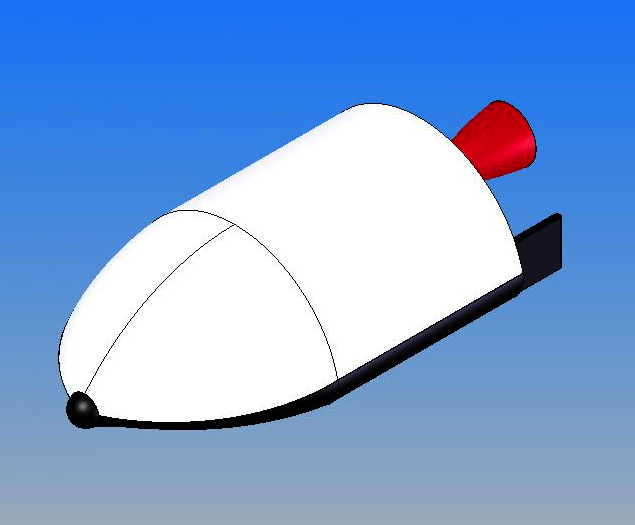
General view of the orbital stage
The orbital stage after separation must include its own engine and carry out the exit to a given orbit. With full payload, the engine can be operated for 334 seconds with ascent into orbit 200 km altitude. After entering the orbit with the required parameters, the payload in the form of scientific equipment or other equipment can begin its work. After completing the tasks, the orbital stage can return to Earth.
For de-orbiting, it is proposed to use a braking impulse that takes the orbital step to the landing trajectory. With the help of thermal protection and a streamlined body shape, the stage without risks enters the dense layers of the atmosphere and enters the landing area. At a given height, it is proposed to open the parachute, which is responsible for the soft landing of the device. Landing "on an aircraft" is not provided for technical and operational reasons. After landing, specialists can begin work with a payload. In addition, it is planned to carry out maintenance of the orbital stage, followed by preparation for a new flight.
A similar algorithm for using the ACS "Blizzard" is proposed for use for scientific purposes. In addition, the possibility of using such equipment in the interests of the armed forces is being considered. In this case, the aerospace system, instead of the orbital stage, can receive combat equipment with the required characteristics. However, the exact parameters of this version of the complex have not yet been determined. At the moment, only the possibility of creating a combat version of "Blizzard" is being considered and possible areas of its application are determined.
The combat version of the AKS "Blizzard" can be the carrier of a shock system or means of intercepting enemy space vehicles. In the latter case, high efficiency of combat work can be obtained, provided the possibility of a fairly simple withdrawal of combat equipment into orbits with various parameters. However, the implementation of such ideas may be associated with some difficulties. First of all, difficulties must be associated with limitations on the mass of the payload. Even a complete replacement of the orbital stage by a special combat system will not allow the creation of a product weighing more than a few tons.
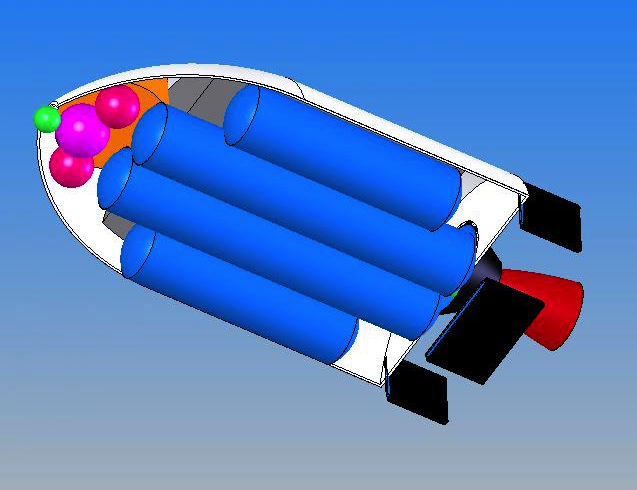
Orbital stage, bottom view, bottom not shown. The white case is marked in blue, the fuel tanks in blue, the engine in red, the parachute compartment in orange, the payload compartment in gray.
The proposed architecture of the aerospace system provides some advantages over other complexes of similar purpose. The main advantages of the project "Blizzard" that can give a significant positive economic effect are the use of the existing aircraft carrier (nevertheless, in need of significant modifications), as well as returning rocket stages. The possibility of multiple use of the first and orbital stages imposes specific requirements on their design, primarily on the characteristics of the engines, but can lead to a noticeable decrease in the cost of individual launches.
The second characteristic advantage of the project is the lack of “binding” to existing space centers. Any aerodrome capable of receiving IL-76 transport aircraft and having a certain set of equipment for working with rocket systems can actually become the launching pad for the AKS "Blizzard". Due to this, the output of the payload to the orbit can be carried out from almost anywhere in the world. As a result, a relatively simple output of the payload to the orbit with the required inclination is provided.
According to reports, at present the project of the aerospace system "Blizzard" from the company "Lin Industrial" remains at the stage of preliminary studies. The general features of the project have been identified, but the technical documentation has not yet been developed. There is information according to which the preliminary version of the project "Blizzard" did not receive the approval of the customer who initiated its development, and, as a result, was left without funding. According to the developer’s estimates, financing for the first stage of research work requires funding in the amount of 3,2 million rubles. Further work will require new investments. At the same time, estimates of the time and financial costs required for the completion of the project are not yet specified.
It should be noted that the project AKS "Blizzard" is not the first such domestic development of its class. Work in this direction in our country started back in the sixties of the last century and was carried out by several organizations led by OKB-155. The aim of the project "Spiral" was the creation of a complex capable of using a hypersonic accelerating plane, a booster block and the so-called. orbital plane to put into orbit a payload. Ready complex "Spiral" could be used for various purposes, primarily in the military.
From the late sixties to the mid-seventies, several prototypes of advanced equipment were built, used in various tests. In particular, the devices of the BOR series made several suborbital and orbital flights. For testing in the atmosphere used the MiG-105.11. After the completion of testing, the work on the Spiral project was discontinued. The customer considered a more promising new project "Energy-Buran". Some prototypes built under the Spiral program later became museum exhibits.
Since the early eighties, NPO Molniya has been developing the project Multipurpose Aerospace Systems (MAKS). It was proposed to include an An-225 carrier aircraft and an orbital aircraft with an additional fuel tank as part of this system. Depending on the configuration, the MAKS complex could deliver the payload to the 7 or 18 orbit. Both automatic cargo and manned versions of the system were considered.
Due to the problems of the early nineties, work on the MAKS project was discontinued. Only in 2012, there were reports of a possible resumption of work and the creation of a modern version of the complex. In addition, the possibility of refining an existing project using other aircraft, etc. was mentioned. As far as we know, in the intervening time, no particular success was achieved in the course of the renewed MAKS project.
With the help of the private rocket-space company Lin Industrial, a new version of a promising aerospace complex is being created that is capable of solving various problems of a scientific and other nature. To date, the overall look of the system has been worked out and its main features, characteristics, etc. have been determined. However, the work can not move forward yet due to lack of funding. Whether the developer company finds an investor and whether it can bring an interesting project to practical implementation - time will tell. If the project AKS “Vyuga” succeeds in reaching at least tests with the orbital stage being put into space, this will be a great success for the entire national space industry, both public and private. However, this success is still far away: the project still needs a long continuation of development.
On the materials of the sites:
https://spacelin.ru/
http://tvzvezda.ru/
http://vpk.name/
https://rg.ru/
http://testpilot.ru/
Page AKS "Blizzard" on the developer's site:
https://spacelin.ru/proekty/aerokosmicheskaya-sistema-vyuga/
- Ryabov Kirill
- "Ling Industrial" / Spacelin.ru
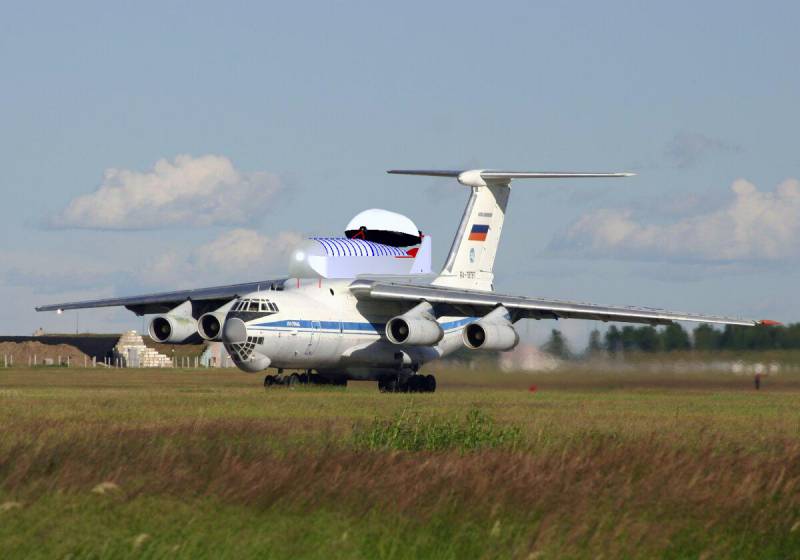
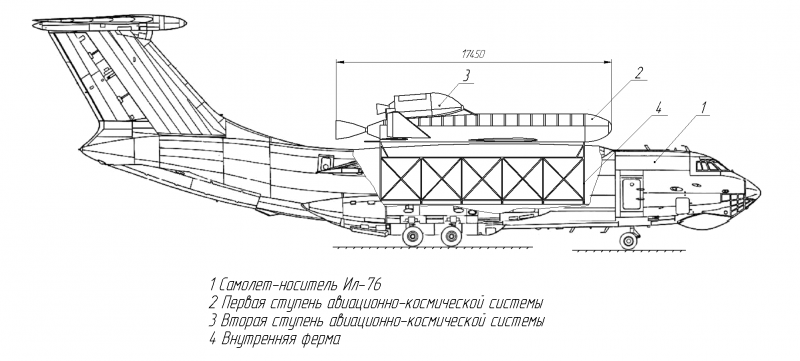
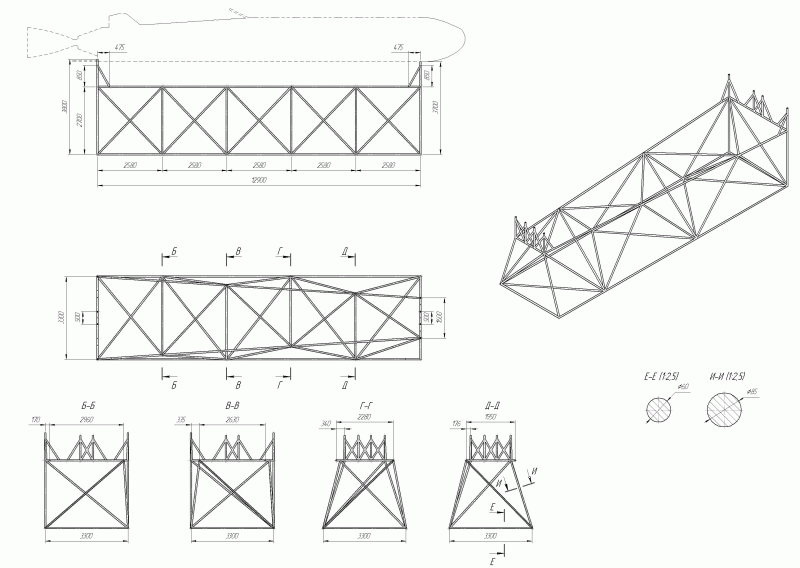
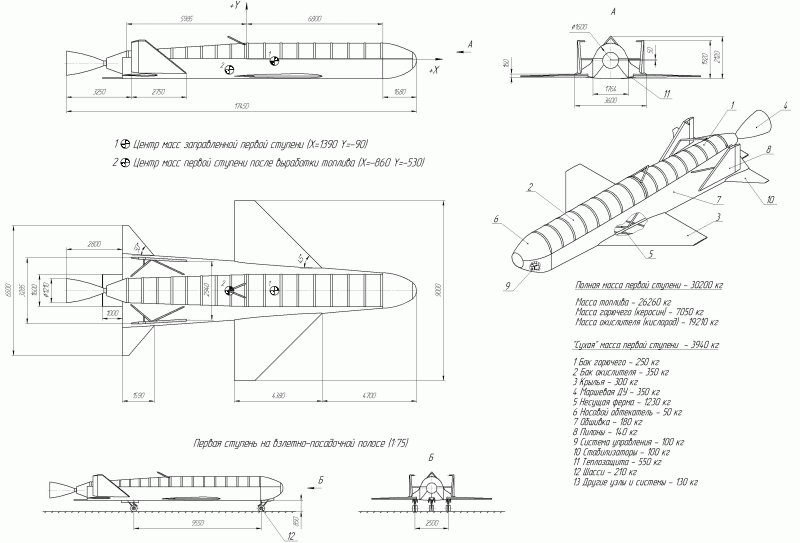
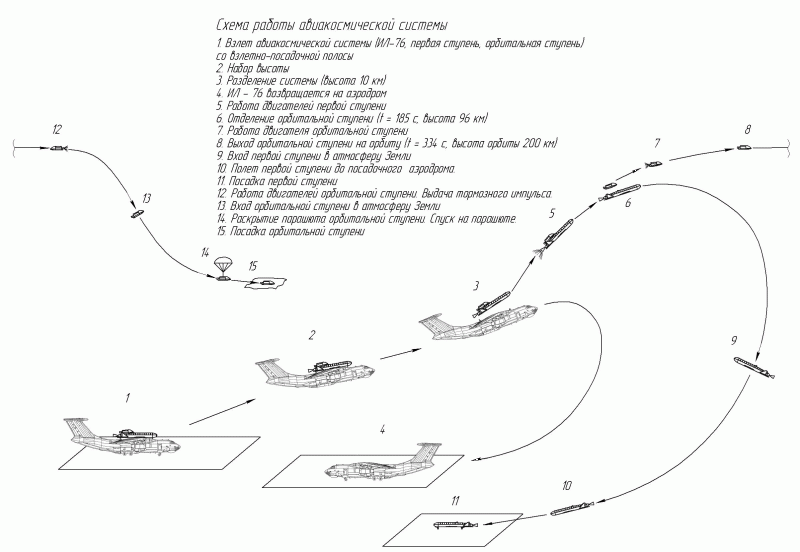
Information